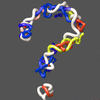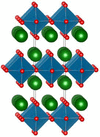issue contents
July 2023 issue

editorial
BIOLOGY | MEDICINE
This editorial acknowledges the transformative impact of new machine-learning methods, such as the use of AlphaFold, but also makes the case for the continuing need for experimental structural biology.
scientific commentaries
NEUTRON | SYNCHROTRON
Commentary is provided on recent magnetic SANS experiments on highly inhomogeneous high-pressure-torsion manufactured metals. The ensuing progress in the theoretical description of magnetic SANS using micromagnetic theory is highlighted.
CHEMISTRY | CRYSTENG
The exciting properties offered by hybrid perovskite-related materials have motivated Liu et al. [(2023). IUCrJ, 10, 385–396] to explore the crystallography of hybrid n = 1 Ruddlesden–Popper phases. Their investigation explores the structures (and symmetries) expected to result from typical distortions and gives design strategies to target specific symmetries.
feature articles
CHEMISTRY | CRYSTENG
Structural distortions in hybrid organic–inorganic layered halide perovskites with the Ruddlesden–Popper structure are classified into 47 different patterns of octahedral tilting via symmetry mode analysis. A survey of known compounds shows that tilt systems with both out-of-phase ϕ-tilts about the a and/or b axes and θ-tilts (rotations) about the c axis are favored over other patterns of octahedral tilting because this combination leads to favorable hydrogen bonding interactions between the organic cations and the inorganic layers.
research papers
NEUTRON | SYNCHROTRON
Download citation


Download citation


Synchrotron nano-diffraction coupled with electron diffraction and spectroscopic techniques revealed the crystal structure of zeolite erionite from Cappadocia. These results fill in the gap for precise modelling of the carcinogenicity of this killer fibre.
CCDC reference: 2256957
NEUTRON | SYNCHROTRON
The role of higher-order small-angle neutron scattering effects in ultra-fine-grained pure iron prepared by combining high-pressure torsion with a post-annealing process is investigated.
NEUTRON | SYNCHROTRON
A pipeline for rapid room-temperature crystal structure determination using a crystallization facility linked to the automated in situ beamline VMXi at Diamond Light Source is described.
PDB references: PHCP at room temperature, 8brl; thaumatin at room temperature, 6rvo; haemoglobin at room temperature, 6sva; ABD08 at room temperature, 8cif; TTCP at room temperature, 8brk; thermolysin at room temperature, 6sel; PHND at 100 K, 7sg6; ABD08 at 100 K, 8bs8; proteinase K at room temperature, 6rzp; lysozyme LCP at room temperature, 8a9d; PHND at room temperature, 7zck; NCO at room temperature, 8ar9
ELECTRON CRYSTALLOGRAPHY
In this study an apparatus for crystal growth which eliminates the preferred orientation problem in electron microscopy and the need for handling of crystal drops prior to microcrystal electron diffraction was designed and 3D-printed. The apparatus was tested on the enzyme proteinase K and its structure was determined by MicroED using this approach.
BIOLOGY | MEDICINE
In a laboratory-directed evolution campaign, the substrate specificity of a bacterial NADH dependent reductase (FucO) has been changed towards accepting bulky aromatic substrates via a two-step evolutionary pathway, in which each step consists of one point mutation. Enzyme kinetic data and crystal structures of the new variant (DA1472) explain the dramatic change of substrate specificity.
PDB references: E. coli FucO mutant L259V complexed with Fe, NADH and glycerol, 7qlg; E. coli FucO mutant N151G/L259V complexed with Fe, NADH and glycerol, 7qnh; E. coli FucO mutant N151G/L259V complexed with Fe, NAD and dimethoxyphenyl acetamide, 7qlq; E. coli FucO mutant N151G/L259V complexed with Fe, NADH and dimethoxyphenyl acetamide, 7qls
CHEMISTRY | CRYSTENG
Download citation


Download citation


Leucopterin, the white pigment in butterfly wings, was found to be a non-stoichiometric hydrate with an extremely high density. The crystal structure and the tautomeric state were investigated by single-crystal and powder XRD, solid-state NMR, DFT-D, Fit with Deviating Lattice parameters (FIDEL) and PDF global fit.
CHEMISTRY | CRYSTENG
High-throughput calculation screening is presented for 87 new low-energy silicon allotropes with monoclinic symmetry.
CRYO | EM
Using fully atomistic multislice simulations and molecular-dynamics treatment of proteins in ice, it is shown that multiple electron scattering is important for the interpretation of cryogenic transmission electron microscopy images to achieve atomic resolution in macromolecules. Cryogenic scanning transmission electron microscopy is demonstrated to yield flat contrast transfer over a wide spatial frequency range, such that integrated centre of mass and ptychography are promising methods for future high-resolution microscopy at low dose while providing a high degree of flexibility in post-acquisition data processing.
MATERIALS | COMPUTATION
Machine learning methods have been applied to solve simple Patterson maps. The results demonstrate the potential to use neural networks for solving the phase problem in crystallography.
CHEMISTRY | CRYSTENG
Download citation


Download citation


A systematic study of a related set of crystalline sponge adsorbate compounds has enabled the investigation of the interplay between guest molecular structure and intermolecular interactions, which furthers our fundamental understanding of the applicability of this characterization method.


 journal menu
journal menu




 access
access


























